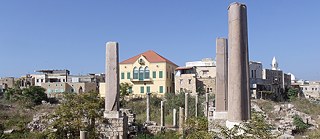Traces of Germany in Lebanon
On the Trail of Barbarossa – The Remains of the German Emperor in Tyre?

In April 1874, the Upper Bavarian church historian and politician Johann Nepomuk Sepp, along with a small group of German scholars and adventurers, embarked on an expedition to the Middle East. They were on a ‘mission for Germany’ to which the Imperial Chancellor Bismarck himself had given his blessing. Their destination was Tyre, which in those days was a sleepy town on the Levant coast. However, the expedition’s focus was not on researching the city’s rich Phoenician or Roman history, but on something much greater: the remains of Emperor Frederick I, known as Barbarossa.
The still-young German Empire had only just put particularism behind it, and thus the plan was to strengthen German national consciousness through shared national myths. One of the most popular of these myths was the legend of Barbarossa, who was said to be sleeping beneath the Kyffhäuser hills, but would one day return and elevate Germany to its old glory. Emperor Wilhelm I regarded himself as standing in the tradition of the Emperor of the Staufer dynasty, styling himself as ‘Barbablanca’, or ‘Whitebeard’. Emperor Barbarossa also happened to be an especially suitable national figurehead because his gravesite was located outside the German Empire. In 1190, during the Third Crusade, he drowned while bathing in a river in Lesser Armenia. The heat made it impossible to transport his body over long distances, so he was boiled and buried in nearby Antioch. His bones, on the other hand, were sewn into a sack, to be buried in Jerusalem, the destination of the Third Crusade. However, the crusaders never made it that far. Historical record is unclear with regard to his final resting place, but later reports claimed that his remains had been buried in the Cathedral of Tyre. This story was the impetus for Johann Nepomuk Sepp’s expedition.
Sepp stated his objective in the preface to his expedition report, “Ocean Voyage to Tyre to Excavate the Cathedral Containing Barbarossa’s Grave”:
“[The] return of old Barbarossa’s remains [will] move the German nation to holy elation. What a triumph to be able to transfer the remains of our greatest Emperor to Cologne Cathedral, a symbol of the faltering old Empire achieving completion by superstruction of the new!”
However, over the course of the expedition report’s 375 pages, it becomes clear that the return of Barbarossa’s bones was not the sole motivation for the expedition. It was also about international recognition of the German Empire, elevating the “late-born German nation back to being the world’s first nation.” Sepp was hardly coy about his colonial ambitions. On the contrary, he openly and vehemently championed them in his report, dedicating an entire chapter to the “People of Tyre’s longing for a German colony”. According to his musings, the entire southern world desired “redemption” by way of German colonies. He suggested that the Imperial Chancellery appropriate Tyre Cathedral as national property, already referring to Tyre as a “new German imperial city”. At a time when the influence of the imperial powers in the Middle East was increasing, Sepp described what was at least a secondary function of research expeditions at the time with startling candour: “Naturalists and historians, linguists and classical scholars paved the way for colonists everywhere.”
Upon arrival in Tyre, the German expedition discovered the remains of the Cathedral of Tyre, which had sustained massive earthquake damage in 1291, and had been completely destroyed when the city was captured by Egyptian Mamluks. The cathedral had been built by crusaders in the twelfth century, after the capture of Tyre. It stood on the foundations of a previous Byzantine church, and its constructors had reused columns taken from Roman ruins. However, the excavations did not yield the desired result: there was no trace of Barbarossa’s remains. The expedition did however discover what appeared to be an empty burial shelf in the nave aisle of the cathedral ruins. Right away, they were certain: this was the proof. The remains of the Staufer Emperor had been laid out here, before being lost when the city was destroyed by the Muslims. Disappointed nevertheless, the expedition departed without the remains.
But even though the expedition did not achieve its aim, it was by no means without results. Johann Nepomuk Sepp had a dozen crates of archaeological findings shipped to Berlin, where the contents were displayed in museums. Although ‘Barbablanca’ was unable to celebrate the return of Frederick I’s remains, the Barbarossa legend lived on in Germany regardless and was closely linked to his person. Two years after the Emperor’s death, work began on the construction of a 81-metre-high Kyffhäuser monument, which in addition to a horseman statue also featured a statue of Barbarossa based on his description in Friedrich Rückert’s poem ‘Old Barbarossa’. The completion of the Kyffhäuser monument in 1896 represented the zenith of Barbarossa’s veneration as national legend. The German Empire’s colonial aspirations, which had been Sepp’s dream, came to influence German colonial policy under Emperor Wilhelm’s grandson and successor Wilhelm II. In Friedrich Rückert’s poem, “the Empire’s glory” would one day be restored by Barbarossa’s return. Wilhelm II attempted this with his colonial policy.
References:
Friedrich Rückert: Barbarossa. In: Kranz der Zeit. Band 2, Tübingen 1817, S. 270 f.
[Verlag Cotta]
Sepp, Johann Nepomuk: Meerfahrt nach Tyros zur Ausgrabung der Kathedrale mit Barbarossa’s Grab, Leipzig 1879. [Verlag von E.A. Seemann]